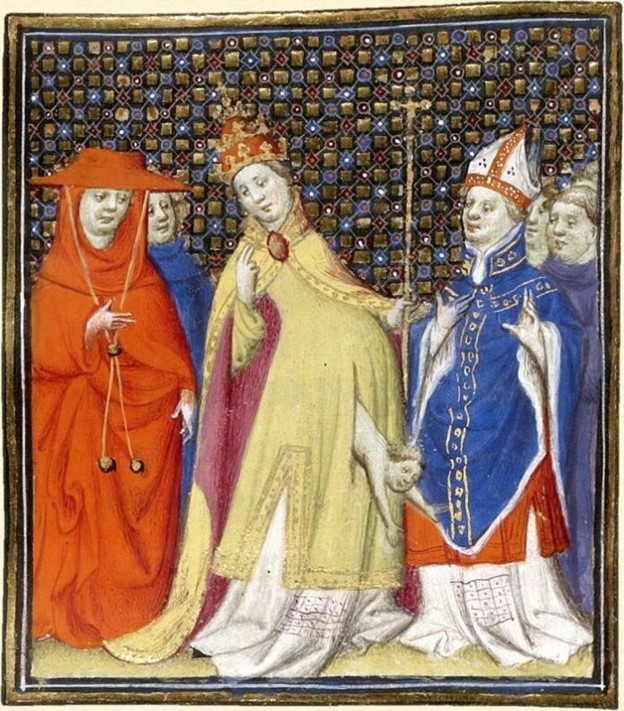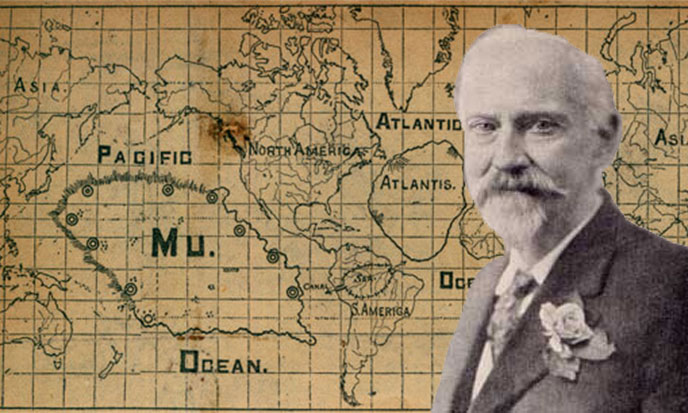Among the popes of the ninth century AD. there was also a female pope. Pope Joan, disguised as a man at the time, under the name of Pope Anglicus VIII, pastored the Catholic Church for 18 months (between March 854 and October 855).
Pope Joan’s childhood
Joan was the daughter of an English monk, Williglad, and Judith (until the tenth century English monks had the right to marry). From England, the monk Williglad is sent, along with his wife, as a missionary to the land of the Saxons, ruled by Emperor Charlemagne (742-814).
In Maienta, in the year 818, Judith gave birth to a beautiful little girl, whom they baptized Joan. Her father taught Joan to read and say prayers in English and Greek, and when Joan turned eight, her mother died.
The father gave Joan to read books on dogmatics, schooling, magic, demonology and others, in order to be well prepared in life. Joan had an amazing memory and held religious sermons with her father. When Joan was 15 years old, her father also died. Due to the lack of shelter and food, Joan, realizing that all she had accumulated was just a certain religious culture, decided to become a nun.
At the Mosbach Abbey
Joan went to the nunnery in Mosbach. Abbess Biltrude, seeing who she was dealing with, installed her in the cell (hermitage) no. 10, which was also the monastery library.
Ioana stayed here for two years, reading what was in the library. Monsignor Raban, the leader of the Benedictine monastery of Fulga, sent the monk Fromentin with a letter to the abbess Biltrude, asking her to send him a copy of the “Epistles of St. Paul”, but written in gold letters. Raban needed this copy because he was waiting for his superior to arrive in a month. In order for this copy to be made as soon as possible, Raban wrote to the abbess to retain Fromentin, who excelled in calligraphy just like Joan.
Abbess Biltrude went with Fromentin to the library; Joan was also there, and after the presentations, she told them what to do, wishing them luck. It was decided that Fromentin would sleep in the hermitage no. 5.
The copying of the Pauline epistles took almost three weeks. During this time, the two young people fell in love (Ioana was 15 years old). The copy of the Epistles being finished, the day of the separation of the two young people ended with tears.
Raban was pleased with the work done by his subordinate. One week later, the gardener of the Mosbach Monastery discreetly handed a letter from Fromentin to Sister Ioana. He asked Ioana for a meeting so she could run away from the monastery.
Joan at the monastery of Benedictine monks
At the place set for the meeting, Joan went immediately. Here Fromentin dressed her in a man’s suit, so that she could be received, without obstacles, as a neophyte, in the monastery of Benedictine monks in Fulga, led by the old senior Raban. Joan thus became “Brother John” and was able to live with Brother Fromentin in the same hermitage.
The young people soon became Raban’s secretaries. Seven years passed without anyone in the monastery suspecting the true identity of Brother John. The monks called him “John the glabrous”, but he did not mind.
There was another glabrous in the monastery, which was also castrated. Everything went well in the 7 “honey” years, until, one night, Father Corbin (the glabrous in the monastery, a eunuch and an intriguer), listening at the door of Fromentin’s cell and hearing love whispers and the bed squeaking, He knocked on their door several times, saying, “Be cursed, you homosexuals!”
The escape of the two young people from the monastery and their wandering
The next morning, they quickly took their donkey and fled the monastery. For almost a year, the two wandered around the world, sometimes on horseback, sometimes on foot, sometimes with ships, until they reached Athens, their current target.
One day, Joan and Fromentin attended a religious service led by the bishop of Athens, Nicetas. As they left the church, the two Benedictine monks, with their hoods pulled over their foreheads, were quickly surrounded by the public to get a better look at them.
Only Bishop Nicetas released them and took them to the episcopal palace, where they were given a house and a table. Nicetas was amazed at how much Father John knew. Ten days later, the two Benedictine monks were housed in the monastery of Daphne, on the outskirts of Athens.
The activity of the young monks in a hermitage near Athens
Bishop Nicetas offered the two Benedictine monks the right to sleep and pray in a vacant hermitage near Athens. Here, Joan and Fromentin lived for eight years. Also here, Father John regularly gave beautiful sermons, which attracted many people from Athens. The world did not know the true identity of Father John.
Fromentin had become more and more jealous of him because he was loved by everyone. Joan was 30 years old and she did not want to stay in that hermitage anymore. She felt that she had another calling to which she had to dedicate herself. With this in mind, the two set off and after a few days arrived in the port of Piraeus, to find a ship bound for Rome.
The call of Rome
As Joan also knew Latin, they found a ship leaving for Rome the next morning. Joan and Fromentin found a small place to sleep for the night. Early in the morning, Joan fled from Fromentin and, on the run, reached the port, boarded the ship and she was gone. Arriving in Rome, Ioana, in monk’s clothes, she looked for work. He appealed to St. Martin’s College and asked to work, for a living.
Once monk John was examined for 3-4 hours and the priests were amazed by his teaching, “he” was immediately appointed professor of theology. And so Joan changed her monk’s coat for a college teacher’s coat, without anyone finding out her true identity. A large audience, often led by Pope Leo IV, attended classes at the College to listen to Professor John.
For several years, Professor John (Joan) taught lessons at this College. This professor’s reputation was well known abroad. Pope Leo, old and rheumatic, appointed Professor John as his assistant, with the title of “secret secretary.” Immediately the teacher received another suit according to the position received.
Joan fulfilled her youth dream
Soon, Pope Leo IV, seeing the love of work and the obedience of his secretary John, named him his son. In time, Secretary John gained the esteem and gratitude of all those who had problems with the Holy See.
After a while, Pope Leon fell ill in bed, where he lay until his death. Before he died, the pope asked Secretary John to take care of his only nephew, Florus, who had not turned 20, a nephew he had raised to the rank of secret chamberlain, ready at any time to be at the pope’s call.
The pope’s funeral ceremonies lasted a few days. A new pope had to be elected. The people of Rome, gathered in St. Peter’s Square, elected Secretary John as pope. Thus he became Pope Anglicus VIII. Joan fulfilled her youth dream.
Ioana, who became Pope
Betrayed by carnal sins
Loved and respected by everyone, the Pope, at the age of 40, felt the need for an intimate love, as he had had with Fromentin for 15 years. As the pope’s bed was next to the room where Florus slept, the pope threw herself into his arms. No one knew about their love. Bad weather came with drought and locusts.
A procession was organized to ask God to save them from the drought. The pope, riding a donkey (as was the custom at the time) and having a severe stomach ache, led the procession to the center of Latra Square, where he stopped. Here the pope climbed the wooden steps of the stairs leading to the towering throne in the middle of the square.
The pope sprinkled the four cardinal points with holy water, then took in his arms a large and heavy icon to make the sign of the cross with it. Suddenly the icon fell from the pope’s hands, then he felt sick, fell and rolled down the stairs, hitting his head on the cobblestones. The priests gathered around the throne and immediately jumped to his aid, loosened his clothes, both on his chest, to get some air, and below to untie his belt.
But suddenly a crying baby fell from the pope’s feet. The priests quickly withdrew, making the sign of the cross, making room for the audience that rushed to the pope, killed him and killed the newborn. God had “revolted” against such a monstrous sacrilege.
Everyone found out that the pope was a woman and her name was Joan. The explanations had been given by Florus, who was there. He buried Ioana right where she had been killed. Florus quickly hid in a monastery where he died.
The moment of the unveiling of Pope Joan (John)
Pope Joan was a bitter lesson for the Vatican. In order not to repeat such a case, the Vatican’s vigilance has been increased. Thus, the future pope is placed on a chair with a large hole cut in the seat, in order to check if he is a man; then the fire in the hearth of a high chimney so that the black smoke might be seen by all; then an announcement is made: “Habemus Papam” (We have a pope!).
Catholics do not want to talk about Pope Joan. They erased her name from the records of the popes, but there are still some documents with her name.








